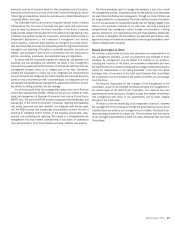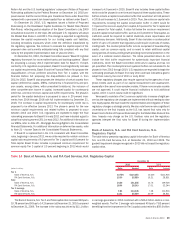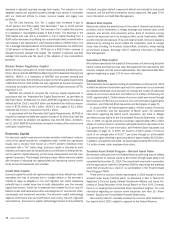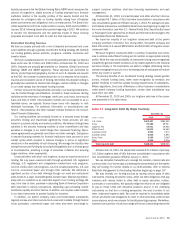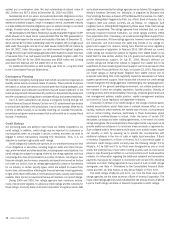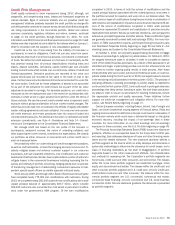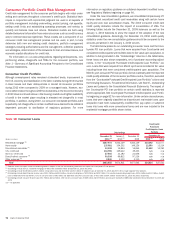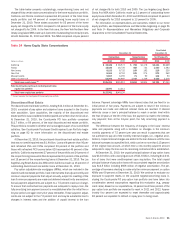Bank of America 2010 Annual Report Download - page 74
Download and view the complete annual report
Please find page 74 of the 2010 Bank of America annual report below. You can navigate through the pages in the report by either clicking on the pages listed below, or by using the keyword search tool below to find specific information within the annual report.
liquidity at the parent company and selected subsidiaries, including our bank
and broker/dealer subsidiaries; determining what amounts of excess liquidity
are appropriate for these entities based on analysis of debt maturities and
other potential cash outflows, including those that we may experience during
stressed market conditions; diversifying funding sources, considering our
asset profile and legal entity structure; and performing contingency planning.
Global Excess Liquidity Sources and Other Unencumbered
Assets
We maintain excess liquidity available to the parent company and selected
subsidiaries in the form of cash and high-quality, liquid, unencumbered secu-
rities. These assets serve as our primary means of liquidity risk mitigation and
we call these assets our “Global Excess Liquidity Sources.” Our cash is primarily
on deposit with central banks, such as the Federal Reserve. We limit the
composition of high-quality, liquid, unencumbered securities to U.S. government
securities, U.S. agency securities, U.S. agency MBS and a select group of
non-U.S. government securities. We believe we can quickly obtain cash for these
securities, even in stressed market conditions, through repurchase agreements
or outright sales. We hold our Global Excess Liquidity Sources in entities that
allow us to meet the liquidity requirements of our global businesses and we
consider the impact of potential regulatory, tax, legal and other restrictions that
could limit the transferability of funds among entities.
Our global excess liquidity sources increased $122 billion to $336 billion
at December 31, 2010 compared to $214 billion at December 31, 2009 and
were maintained as presented in the table below. This increase was due
primarily to liquidity generated by our bank subsidiaries through deposit
growth, loan repayments combined with lower loan demand and other factors.
Table 16 Global Excess Liquidity Sources
(Dollars in billions)
2010 2009
December 31
Parent company
$121
$99
Bank subsidiaries
180
89
Broker/dealers
35
26
Total global excess liquidity sources
$336
$214
As noted above, the excess liquidity available to the parent company is
held in cash and high-quality, liquid, unencumbered securities and totaled
$121 billion and $99 billion at December 31, 2010 and 2009. Typically,
parent company cash is deposited overnight with Bank of America, N.A.
Our bank subsidiaries’ excess liquidity sources at December 31, 2010
and 2009 were $180 billion and $89 billion. These amounts are distinct from
the cash deposited by the parent company, as described above. In addition to
their excess liquidity sources, our bank subsidiaries hold significant amounts
of other unencumbered securities that we believe could also be used to
generate liquidity, such as investment-grade ABS, MBS and municipal bonds.
Another way our bank subsidiaries can generate incremental liquidity is by
pledging a range of other unencumbered loans and securities to certain
Federal Home Loan Banks and the Federal Reserve Discount Window. The
cash we could have obtained by borrowing against this pool of specifically
identified eligible assets was approximately $170 billion and $187 billion at
December 31, 2010 and 2009. We have established operational procedures
to enable us to borrow against these assets, including regularly monitoring our
total pool of eligible loans and securities collateral. Due to regulatory restric-
tions, liquidity generated by the bank subsidiaries can only be used to fund
obligations within the bank subsidiaries and cannot be transferred to the
parent company or nonbank subsidiaries.
Our broker/dealer subsidiaries’ excess liquidity sources at December 31,
2010 and 2009 consisted of $35 billion and $26 billion in cash and high-
quality, liquid, unencumbered securities. Our broker/dealers also held
significant amounts of other unencumbered securities we believe could also
be used to generate additional liquidity, including investment-grade corporate
securities and equities. Liquidity held in a broker/dealer subsidiar y is only
available to meet the obligations of that entity and cannot be transferred to
the parent company or to any other subsidiary, often due to regulatory
restrictions and minimum requirements.
Time to Required Funding and Stress Modeling
We use a variety of metrics to determine the appropriate amounts of excess
liquidity to maintain at the parent company and our bank and broker/dealer
subsidiaries. One metric we use to evaluate the appropriate level of excess
liquidity at the parent company is “Time to Required Funding.” This debt
coverage measure indicates the number of months that the parent company
can continue to meet its unsecured contractual obligations as they come due
using only its Global Excess Liquidity Sources without issuing any new debt or
accessing any additional liquidity sources. We define unsecured contractual
obligations for purposes of this metric as maturities of senior or subordinated
debt issued or guaranteed by Bank of America Corporation or Merrill Lynch &
Co., Inc., including certain unsecured debt instruments, primarily structured
notes, which we may be required to settle for cash prior to maturity. The
ALMRC has established a target for Time to Required Funding of 21 months.
Time to Required Funding was 24 months at December 31, 2010 compared to
25 months at December 31, 2009.
We utilize liquidity stress models to assist us in determining the appro-
priate amounts of excess liquidity to maintain at the parent company and our
bank and broker/dealer subsidiaries. These risk sensitive models have be-
come increasingly important in analyzing our potential contractual and con-
tingent cash outflows beyond those outflows considered in the Time to
Required Funding analysis.
We evaluate the liquidity requirements under a range of scenarios with
varying levels of severity and time horizons. These scenarios incorporate
market-wide and Corporation-specific events, including potential credit ratings
downgrades for the parent company and our subsidiaries. We consider and
utilize scenarios based on historical experience, regulatory guidance, and
both expected and unexpected future events.
The types of contractual and contingent cash outflows we consider in our
scenarios may include, but are not limited to: upcoming contractual maturities
of unsecured debt and reductions in new debt issuance; diminished access to
secured financing markets; potential deposit withdrawals and reduced roll-
over of maturing term deposits by customers; increased draws on loan
commitments and liquidity facilities; additional collateral that counterparties
could call if our credit ratings were downgraded; collateral, margin and sub-
sidiary capital requirements arising from losses; and potential liquidity re-
quired to maintain businesses and finance customer activities.
We consider all sources of funds that we could access during each stress
scenario and focus particularly on matching available sources with corre-
sponding liquidity requirements by legal entity. We also use the stress mod-
eling results to manage our asset-liability profile and establish limits and
guidelines on certain funding sources and businesses.
Basel III Liquidity Standards
In December 2010, the Basel Committee on Bank Supervision issued “In-
ternational framework for liquidity risk measurement, standards and moni-
toring,” which includes two measures of liquidity risk. These two minimum
liquidity measures were initially introduced in guidance in December 2009 and
are considered part of Basel III.
The first liquidity measure is the Liquidity Coverage Ratio (LCR) which
identifies the amount of unencumbered, high quality liquid assets a financial
institution holds that can be used to offset the net cash outflows the insti-
tution would encounter under an acute 30-day stress scenario. The second
72 Bank of America 2010





